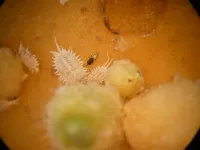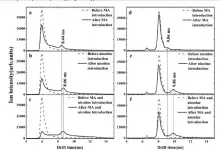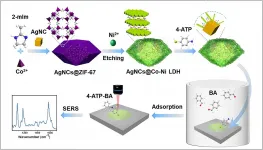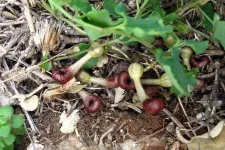(Press-News.org) A CABI-led study has revealed that the success of Classical Biological Control (CBC) in Europe, North Africa and the Middle East is only rarely dependent on the released biological control agent, but more often on other factors, such as the target pest, its host plant, or the circumstances of the releases.
The research - published in the journal NeoBiota - suggests that the overall success of biological control introductions of insect predators and parasitoids against herbivorous insects in the Western Paleartic ecozone is comparable to the success of CBC worldwide. However, over 100 years of CBC in this region, has resulted in no overall rise in success in the fight against insect pests - including those of crops such as citrus, olive, potato, mulberry and various other fruits.
Lead author Dr Lukas Seehausen, together with colleagues from CABI Switzerland, the University of Lisbon and the University of Bordeaux, argue that a focus on life-history traits of the biological control agent to increase the chances of successful CBC is not fully justified and should be complemented with the consideration of traits regarding the pest and its host plant, as well as other aspects of CBC, such as climate and management - including ways in which CBC agents are released.
For example, if a CBC agent is released repeatedly against the same pest in different years and countries, the chances of successful establishment and control of the target increase. This is an indication for the importance of release strategies for the success of CBC programmes.
Dr Seehausen said, "What makes our study different from others is that we studied factors that may impact the outcome of CBC not independently of each other but using a holistic analysis, which reveals their relative importance within the complexity of CBC programmes.
"The results from this study should be understood as a first step to give the incentive for a holistic, rather than an independent consideration of factors affecting the success of CBC."
By filtering data from the BIOCAT catalogue, the scientists found that 780 introductions of insects for biological control were undertaken in the Greater Western Palearctic ecozone between 1890 and 2010. This constituted 416 agent-target combinations.
The results showed that eight countries were responsible for more than two thirds (70.5%) of all introductions: Israel (16.3%), Italy (14.0%), Former USSR (10.1%), France (7.3%), Greece (7.1%), Spain (6.0%), Egypt (5.3%), and Cyprus (4.4%). Within these countries, the percentage of complete target control was very variable.
Overall, the study showed that while the success of agent establishment was 32%, the successful impact of single agents on their target was 18% and the success of complete control was 11%.
However, the success rates of agent establishment and target control were higher in CBC projects targeting pests of woody plants than pests of other types of plants.
A reason for this, the scientists say, might be that being perennial, trees provide a more stable and predictable environment when compared to herbaceous plants such as annual plants or crops.
In carrying out the research, Dr Seehausen and the team added 15 new explanatory variables including consideration of the biological control agent feeding strategy, host range and life-stage killed by the biological control agent.
Dr Seehausen explains, "We found that only a few CBC agent-related factors significantly influenced the success of CBC - suggesting that the reoccurring focus on agent-related traits is not justified.
"Our attention should be redirected to include lower trophic levels and other aspects of CBC - such as abiotic factors including climate and management."
The scientists conclude by stressing that analysis of the entire BIOCAT catalogue, or an updated version including more factors, should lead to further insights and help to develop decision support tools to increase the success of CBC at all levels.
INFORMATION:
Notes to editors
Full paper reference
Seehausen. M.L, Afonso. C, Jactel. H, Kenis. K, 'Classical biological control against insect pests in Europe, North Africa, and the Middle East: What influences its success?' 10 June, 2021, NeoBiota, DOI: 10.3897/neobiota.65.66276
This paper can be read open access from 14:00hrs GMT, 10 June, 2021, here: https://doi.org/10.3897/neobiota.65.66276
Acknowledgement
The research leading to these results received funding from the European Union's Horizon 2020 Program for Research & Innovation under grant agreement no. 771271 (HOMED). MLS and MK were supported by CABI with core financial support from its member countries (see https ://http://www.cabi.org/about ?cabi/who?we?work?with/key?donors/). CA was supported by a PhD grant (SFRH/BD/135845/2018) from Fundação para a Ciência e a Tecnologia (FCT).
Media enquiries
Wayne Coles, Communications Manager, CABI, email: w.coles@cabi.org Tel: +44 (0)1491 829395
Dr Lukas Seehausen, Research Scientist, Risk Analysis & Invasion Ecology, CABI, email: l.seehausen@cabi.org
About CABI
CABI is an international not-for-profit organization that improves people's lives by providing information and applying scientific expertise to solve problems in agriculture and the environment.
Through knowledge sharing and science, CABI helps address issues of global concern such as improving global food security and safeguarding the environment. We do this by helping farmers grow more and lose less of what they produce, combating threats to agriculture and the environment from pests and diseases, protecting biodiversity from invasive species, and improving access to agricultural and environmental scientific knowledge. Our 50 member countries guide and influence our core areas of work, which include development and research projects, scientific publishing and microbial services.
We gratefully acknowledge the core financial support from our member countries (and lead agencies) including the United Kingdom (Foreign, Commonwealth and Development Office), China (Chinese Ministry of Agriculture and Rural Affairs), Australia (Australian Centre for International Agricultural Research), Canada (Agriculture and Agri-Food Canada), Netherlands (Directorate-General for International Cooperation, and Switzerland (Swiss Agency for Development and Cooperation). Other sources of funding include programme/project funding from development agencies, the fees paid by our member countries and profits from our publishing activities which enable CABI to support rural development and scientific research around the world.
The COVID-19 pandemic has made clear the importance of understanding precisely how diseases spread throughout networks of transportation. However, rigorously determining the connection between disease risk and changing networks--which either humans or the environment may alter--is challenging due to the complexity of these systems. In a paper publishing on Thursday in the END ...
Quantum coherence is a key ingredient in many fundamental tests and applications of quantum technology including quantum communication, imaging, computing, sensing and metrology. However, the transfer of quantum coherence in free-space has so far been limited to direct line-of-sight channels as atmospheric turbulence and scattering degrade the quality of coherence severely.
In a new paper published in Light: Science & Applications, researchers from the University of Waterloo have successfully demonstrated the transfer and recovery of quantum coherence using photons scattered in free-space ...
Recently, a research group led by CHU Yannan and HUANG Chaoqun from the Institute of Health & Medical Technology of the Hefei Institutes of Physical Science (HFIPS) developed an effective method for on-site detection of methamphetamine (MA) in the presence of nicotine by a homemade ion mobility spectrometry. Relevant results were published in Analytical and Bioanalytical Chemistry.
MA is a highly addictive stimulant that affects the central nervous system. The on-site rapid detection of trace amounts of MA and screening illicit drugs in clandestine laboratories are important for drug enforcement agencies and the forensic community in general. However, detecting MA in the ...
Lack of water, floods, or crop losses: As a result of climate change, pronounced periods of drought and rainfall are occurring more frequently and more intensively all around the world, causing human suffering and major economic damage. The more precise seasonal forecasts for the coming months are, the more effectively these consequences can be mitigated. A research team from Karlsruhe Institute of Technology (KIT) has now been able to improve global forecasts using statistical methods so that they can be used on the regional level. The researchers describe the new approach and the economic benefits of ...
Prof. HUANG Qing's group from the Hefei Institutes of Physical Science (HFIPS) developed a surface-enhanced Raman spectroscopy (SERS) gas sensor to detect aldehyde with high sensitivity and selectivity, which provided a new detection method for studying the adsorption of gas molecules on porous materials. The relevant research results have been published in Analytical Chemistry.
Adsorption technology is one of the main technologies for treating Volatile organic compounds (VOCs). Over the past years, metal-organic frameworks (MOFs) have attracted high interest for their outstanding adsorption property. Closely related to MOFs, layered double hydroxides (LDHs), also known as hydrotalcite-like ...
The annual number of new HIV infections among men who have sex with men (MSM) in England is likely to have fallen dramatically, from 2,770 in 2013 to 854 in 2018, showing elimination of HIV transmission by 2030 to be within reach - suggests work by researchers from the MRC Biostatistics Unit at the University of Cambridge and Public Health England (PHE), published in The Lancet HIV.
To manage the HIV epidemic among MSM in England, enhanced testing and earlier treatment strategies were scaled-up between 2011 and 2015 and supplemented from 2015 by pre-exposure prophylaxis (PrEP). The researchers examined the effect of these interventions on the number of new infections and investigated ...
Researchers have made progress towards a G7 commitment to establish safe standards for the release of antimicrobials into the environment, by developing a new framework that establishes safe thresholds.
The threat of bacteria developing resistance to antimicrobial drugs (often called antibiotics) used to treat infection is one of the greatest global health challenges, potentially resulting in 10 million deaths per year by 2050.
A major issue is the spread of antimicrobials and resistant bacteria through water systems. When we take antibiotics, 70 per cent passes through our bodies into wastewater. Farm animals are treated with antibiotics which ...
Plants use numerous mechanisms for their pollination. Now botanists have discovered a particularly sophisticated system among pipevines that is based purely on deception.
The flowers of the Greek plant Aristolochia microstoma emit a foul, musty scent that seems to mimic the smell of decaying insects. The fly pollinators from the genus Megaselia likely get attracted to this odor while searching for arthropod corpses to potentially mate over and lay their eggs. Then, when entering the tube of an Aristolochia flower, the flies are guided by downward-pointing hairs into a small chamber, which holds the female and male floral organs. Trapped inside, they deposit pollen they carry onto the stigma, before the stamens ripen and ...
It eventually became a Nobel prize-winning revolution when researchers first engineered CRISPR as a gene editing technology for bacterial, plant, animal and human cells. The potential of the technology is great and span from curing genetically disposed diseases to applications in agricultural and industrial biotechnology, but there are challenges.
One such challenge consists of selecting a so-called gRNA molecule which should be designed to guide the Cas9 protein to the right location in the DNA where it will make a cut in relation to the gene editing.
"Typically, there are multiple possible gRNAs and they are not all equally efficient. Therefore, ...
Using a new 3D printing process, University of Nottingham researchers have discovered how to tailor-make artificial body parts and other medical devices with built-in functionality that offers better shape and durability, while cutting the risk of bacterial infection at the same time.
Study lead, Dr Yinfeng He, from the Centre for Additive Manufacturing, said: "Most mass-produced medical devices fail to completely meet the unique and complex needs of their users. Similarly, single-material 3D printing methods have design limitations that cannot produce a bespoke device with multiple biological or mechanical functions.
"But for the first time, using a computer-aided, multi-material ...







